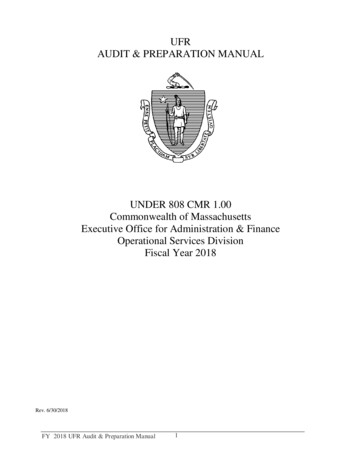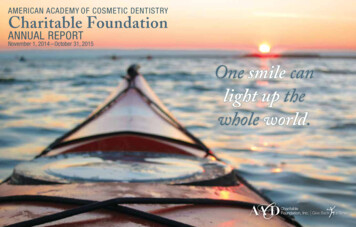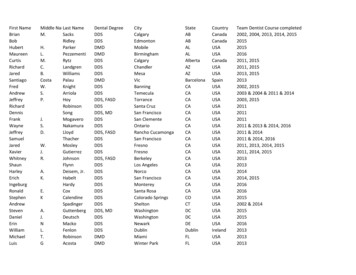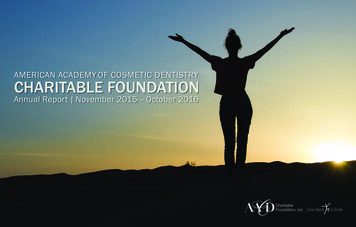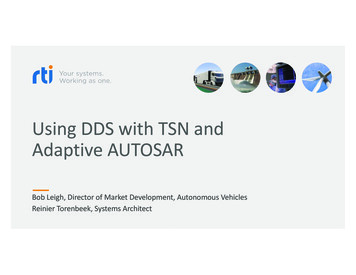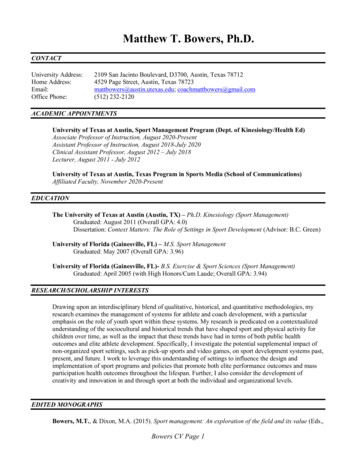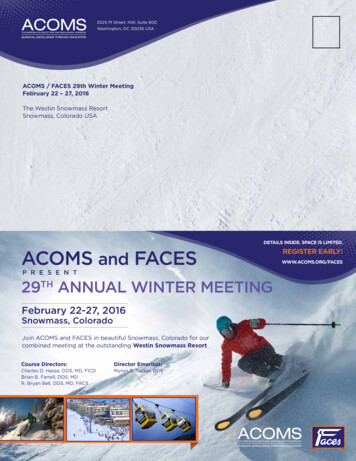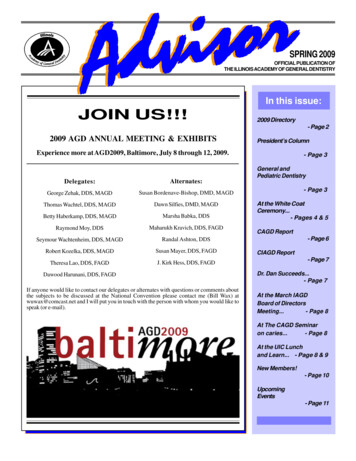
Transcription
Charles Michael Bowers DDS, JDDental and Forensic Services2284 South Victoria Ave., Suite 1-GVentura, CA 93003805-642-0381805-656-3205 fax805-701-3024 cellcmbowers@aol.comJanuary 26, 2014To:National Commission on Forensic ScienceRE:Personal comment submissionHello:Please accept the attached documents as background information for theCommission’s deliberations. The first document is a recent chapter contribution Iwrote for Elsevier/Academic Press regarding “bite mark identifications” and thecriminal justice system’s response to issues regarding expert reliability andwrongful convictions. Bite mark identification was covered in chapter five of theNational Academy of Sciences report, Strengthening Forensic Science in theUnited States: A Path Forward, and serious concerns were raised regarding itsvalidity and reliability. The second document is a peer reviewed article, Problembased analysis of bitemark misidentifications: The role of DNA, which wasreferenced and cited by the NAS in their Report.Although my chapter focuses on a specific forensic field, it also describes thestatus of forensic accreditation administered by organized forensic groups. Ipresent systemic problems associated with self-administered validity testing bypractitioners of weak forensic science. I believe these issues are applicable tothe Commission’s scope of activities.Regards,C. Michael Bowers DDS JD
Reprint permission given by Elsevier/Academic Press. This chapter occurs in “Miscarriages of Justice,”Brent Turvey and Craig Cooley co-editors, ISBN: 9780124115583, in press 2014.Bite Mark Evidence and Miscarriages of JusticeC. Michael Bowers, DDS, JDFellow, American Academy of Forensic Sciences“When science advances beyond a previously accepted forensic discipline”INTRODUCTIONThis chapter in “Miscarriages of Justice” provides the reader with an overview of theadversarial process in the US criminal justice system regarding a specific type ofscientific evidence used to convict defendants. The forensic subject is bite markidentification. This is a subset of forensic odontology (dentistry) which principallyidentifies humans from dental records and post mortem dental autopsies.1 Dentists callthis subset “shape analysis” but the broader forensic community considers it within thebroader subject of “pattern analysis.”2 For decades, the criminal justice application ofthis small “scientific” community’s (following the Frye Rule definition) bite mark tenets(now being expressed by its certifying board as a “non-scientific” process 3 4 whencombined with the US courts’ slow response to scientific advances and legal case law isproblematic. A meta-data analysis of their cases and accompanying uncompelling“validation” literature points to its core failure of preventing false positive expert opinionsin criminal proceedings. Despite the truth of these matters, which reflect poorly on thepublic’s beliefs of criminal justice (i.e. “CSI effects”), it still exists in every US state as along admissible method of forensic opinion. Bite mark proponents currently are battlingfor survival against both new science (DNA and other research) and their record of1
assisting in wrongful convictions and arrests. Simply put, for decades, they have misidentified innocent criminal defendants. Unfortunately, the battle regarding exclusion ofbite mark opinions is being fought in a piecemeal manner (case by case; state by state)due to the multi-structured and independent US state court system and lax judicialforensic quality control. The 1993 Daubert framework for “gatekeeping” bad science,conjoined with no control from federal governmental oversight (the 2009 NAS Reportrecording similar criticisms, but is repeatedly denounced as a mandate by prosecutorsand their reviewing judiciary)5 continue to allow the unfettered use of this “impressionevidence.”6 All this legal inaction prevents a global decommissioning for bite markidentification. Coupled with a lack of rigorous organized forensic review of the casedata is the fact that prosecutors are also immune 7 from legal scrutiny and sanctionswhen they continue to use bitemark evidence as proof of guilt. Additionally, mostprosecutors do not admit mistakes when their bite mark cases have been quashed onappeal, the convictions vacated, and the defendant exonerated.8 The appellate systemin some cases has responded to the availability of post-conviction DNA science toquash prosecutorial bite mark evidence used at trial and to overturn convictions. 9 Asmentioned above, this is reflected in the exoneration cases. However, this newevidence is commonly opposed by prosecutors in post-conviction appeals. They presentarbitrary excuses and ill-founded theories of continued guilt which continue the legaldebate for years in many cases (See Section D in this chapter). To date, no US courthas been capable of undertaking a legitimate scientifically relevant inquiry anddetermining this type of evidence as invalid 10 despite published scientific and legalcriticisms based on erroneous convictions. 112
Factors indicating the fraud of bite mark identification’s judicial admissibility as aforensic “science.”1. Its meager scientific literature has become the “poster child” for non-forensic science.It is a method that has no university-based applied scientific precursors (unlike DNA)that support its continued use as a reliable forensic practice for use in criminal courts.12The scientific underpinnings of bitemark identification are merely a collection of beliefsand attitudes rather than hypotheses driven by validation and research experimentation(also unlike DNA).2. Its continued acceptance by the US courts since 1954, despite 2009 findings by theUS National Academy of Sciences, the methods and guidelines of bitemark experts hasnot been scientifically validated.133. Empirical evidence from legal research of cases by the Innocence Project and otherlegal authorities that bitemark opinions have contributed to dozens of wrongfulconvictions and arrests in the US.4. DNA has replaced bitemark “matching” as the premier method of biter identificationregardless of the platitudes of practitioners of this impression comparison method. Ifproper crime scene protocols are followed, many cases allow recovery and biologicalanalysis of saliva left from bitten skin and clothing covering the injury area.14 Thismodality of DNA capture from saliva has been in existence since the late 1990’s and3
has continued to be refined via improvements in the ability to produce a completebiological profile from increasingly smaller samples. These advances have alsoimpacted the long accepted use of fingerprint identification and other impressionevidence methods, such as firearm and tool mark identification.15A. Overview of bitemark comparisons’ professional status of its practitioners.TrainingUnlike forensic pathology in medicine, forensic dentistry is not a recognized as aspecialty of dental practice (i.e. the American Dental Association has no standards forthis aspect of dental activity) or included in the Federal Bureau of Investigation’s, orother law enforcement crime labs. Also unlike medicine, there are no forensic residencyprograms for dentists in the United States. Existing forensic training exists only asonline and short course programs with mentorship available in some circumstances.EmploymentThe typical forensic dental expert is an independent contractor who is not an employeeof a governmental laboratory or law enforcement agency. This is important in therespect that the analytical protocols, work product and opinions of a bitemark expert arenot supervised. A popular trend of a few bitemark examiners is to use a secondindependent dental examiner to peer review the bitemark and suspect evidence for“quality control.” This is an unsophisticated substitute for methods widely used withinprofessional crime labs to prevent contact between examiners working on the same4
cases. Despite this purported safeguard, the methods bitemark examiners adoptamongst themselves are not validated by independent scientific study and cannot besolved by a second review using methods that are not validated.B. Bitemark Analysis: The Evidence, Methods and AssumptionsThe Bite EvidenceHuman and animal bitemarks commonly are seen in criminal and civil cases involvingassaults, child and elder abuse and homicides. This evidence mostly occurs as markson human skin, although occasionally tooth marks are seen in foodstuffs and otherinanimate objects. The presentation of this evidence is generally reflected by bruising inthe skin injuries and by indentations of front teeth on substrates such as Styrofoamcups. The skin injuries are extremely variable in pattern shape and detail definition dueto the physical properties of human skin. The bulk of skin injuries of this type are of littlepattern analysis value (i.e., the ability to reliably “match” to a known human being’steeth). They seldom show an undistorted pattern necessary to even identify individualteeth. Bitemarks from homicides and violent attacks appear to possess more detail thanin child abuse cases, although no research is available on the subject. Any guidelinesfor determining the minimum detail necessary to comparisons of these varying patternsare non-existent (i.e., a threshold minimum for use in court). The skin evidence isgenerally ambiguous and the standards for interpretation are not available. These aremajor reasons that bite mark interpretations for biter identification purposes arespeculative and unreliable. The best available crime scene protocol in circumstances5
involving a purported bite mark is the transfer of saliva with its accompanying genomicDNA. The necessity of timely collection is paramount. The crime scene or victiminvestigator must be trained in the recognition of suspected bite mark evidence andDNA collection from skin, clothing overlying a bitemark and objects associated aspossibly having been bitten. The proper preservation of this evidence is a paramountresponsibility of law enforcementThe Suspect’s Dental EvidenceLaw enforcement investigations generally start with a list of “suspects” or “persons ofinterest.” Starting in the US in the 1950’s, the presence of bite mark injuries in a caseraised the question regarding the biter’s dental characteristics seen in the injury. Thedental examination of any suspect involves the production of plaster casts taken fromstandard dental impression materials. This information may be legally obtained from aseries of suspects in a single case.The MethodsA bitemark expert compares latent (meaning the pattern in the bruise is incomplete)bruises on the skin present on a crime victim with the front teeth a criminal suspect(sometimes multiple suspects) suspected of being the biter. Cases exist where avictim’s teeth created a bite mark on the assailant. In either case, the comparison ofteeth to bitemark is a matter of choice for dental examiners. No list of comparisonmethods (varying from diverse digital comparison of injury photographs to no methodother than the examiner’s visual comparison of the evidences’ “shape”) are published by6
any US forensic dental organization, including the American Board of ForensicOdontology. None of these methods have been tested for reliability of measurementtechniques, accuracy, reproducibility of different methods by different examiners,physical distortion limitations or dental similarities amongst a realistic population ofhuman subjects (DNA has this data). Additionally, there are no recommendations forwhich method is best in the varying physical circumstances seen in crime scenes, victimtype or locations of injuries seen on victim’s body (i.e., child, adult, senior citizen; breast,arm, leg neck, torso or extremities).Bitemark Evidence: Images of the evidence used by police and the courts.Generally, photographic images are presented to demonstrate evidence considered bythe bitemark expert. The variations of patterns in shape and resolution seen in theseskin injury patterns and some inanimate objects (i.e. clothing) considered to be made byhuman teeth are significant. Actual cases brought into investigations and the criminalcourts by prosecutors and their bitemark experts show significant levels of expertdisagreement.16The Dentists’ Bitemark Opinions Currently, bitemark “identifications” have devolved tothe state where dentists may avoid saying a specific person is the “biter” with “medicaldental certainty” or a “positive match.” The increasing number of erroneous bite markopinions aiding erroneous conviction cases has had a major chilling effect on thecontents of their recent opinions. These cases of erroneous convictions have leftprosecution dentists with massive liability in civil litigation after the defendant is freed.7
Despite this, the few remaining adherents in the bite mark community speak loudly oftheir value to the US justice system and profess they can still identify “the biter.”17 Theysubstitute statements such as the suspect “cannot be ruled out,” “is a possible biter” orsomething similar and just as ambiguous. These semantics are confusing, untestablefor accuracy and commonly misinterpreted by juries.The Assumptions Present in the OpinionsBite mark adherents presuppose numerous other unvalidated assumptions. The recentresearch uncovering these myths has been noticed by the American Dental Association.181. These experts have no control of the physical properties of skin (aka“anisotropy, i.e. stretching, tearing, etc.) and lack studies focusing on thematch rate of tooth arrangements in the human population. Most admit skindistortion exists but disclaim or ignore it in actual casework. This is a personalassumption. Some even use Adobe Photoshop to “arbitrarily correct” for it.192. The human dentition is unique. Adherents consider this the equivalent of afingerprint. It is a weak substitute for doing legitimate research on thesubject that human skin can accurately reflect and maintain the teethpattern‘s uniqueness. Research contradictions to this tenet are similar to item1.3. Probabilities of matches between a suspect and evidence can be determinedby the expert without any scientific foundation or proofs.8
C. A Brief Legal DiscussionLike all forensic identification “sciences”, the claims of the field of forensic odontologyclearly are measureable to a certain extent and therefore able for review under thejudicial rules and “tests” for evaluating experts’ scientific claims. To date there havebeen no exclusions of bitemark evidence in US, whether a court uses either the Daubert(1993) or Frye (1923) tests for scientific validity in forensic science subjects. Mostresearcher and legal experts admit that any court system and its rule makers are poorlyequipped to have personal experience in vetting expert witnesses on scientific merits.The court system appears to be unmoved with this method’s lack of validity testing andgenerally prefers the tried and very unscientific attitude that “stare decisis” (precedencesetting cases from the past) as a substitute for foundational scientific scrutiny. Againstthose criteria, bitemark identification encounters several interesting problems. Clearly,the nature of dentition and the asserted skills of forensic dentists are testable, and theNAS 2009 report said as much, but the practitioners are not equipped, nor inclined topursue research in any modern context. A relatively recent investigation by the USCongress bypassed bite mark matching as deserving of added funding.20 Thepractitioners are much more content to just criticize relevant research that does notsupport their assumptions.21What is evident from the literature which can be used to predict a semblance ofaccuracy for bitemark methods suggests an unacceptably high rate of error. Both withthe exoneration case results and the few empirical studies, the unerring conclusion isthat the multiple variables and challenges inherent to this type of pattern evidence9
overwhelms the “art and science” of its practitioners. The bitemark adherents say thewrongful convictions are due to “rogue” practitioners.22Legal arguments currently being used to exclude bitemark experts from testifying incourt submit that bitemark injuries are relevant evidence in criminal cases, but only forthe instances where DNA has been collected from the bitten area. In cases where DNAis not available, any theory on the biter’s identification from a pattern is argued as adetriment to the defendant’s constitutional right to a fair trial. Further arguments againstadmissibility focus on its non-science status, case research of erroneous opinions andunacceptable expert conjecture.D. The William Richards Story: A case study on inexpert investigation and forensicanalysis leading to an ongoing “miscarriage of justice.”A late evening emergency call to law enforcement in a rural desert area of Californiaresulted in the first responder arriving on private property and contacting the male caller.The resident said his wife had been attacked by an unknown person(s) and showed theofficer where she lay outside their small trailer. The woman had massive head injuriesand was deceased.The scene was processed by police the following morning when the county coronerremoved the remains and detectives arrived once the sun came up. The victim was leftunprotected on the property as the security officer was stationed at the entrance to theproperty along a highway. Three or four dogs entered the scene and partially buried thebody.10
Police omissions and misdirection of investigatory interestThe officer who first responded considered the husband the prime suspect as he hadblood on his clothes, was not significantly despondent at the scene (i.e., not behavingas would be expected considering the circumstances), and in an act of forensic magic,determined on the scene that the woman had been recently murdered, thus eliminatingthe husband’s time alibi (he came home from work and found her body). Detectives andthe District Attorney concurred and the husband was eventually convicted (after fourtrial attempts).23Admission of the officer’s statements regarding the following should have beenconsidered suspect at trial:1. His “expertise” on time of death (TOD) was later admitted at trial asbeing based on attending a first aid class in the military. This convenientlyavoided the improper security of the scene and failure of the SheriffCoroner to establish TOD estimates near the time of first contact at thescene.2. Tests regularly conducted in death investigation SOPs to establishTOD (like core body and liver temperature) were not conducted, leavingthe first responding officer’s opinion that the victim was not dead very longthe only opinion available.3. His observations of inappropriate behavior of the husband at the scenewere clearly an attempt to discredit the husband without any basis of11
reliability. The DA did proffer him as an expert trained to psychologicallyprofile persons considered as suspects in a crime.Other forensic misdirection occurred at the last and final trial before conviction wasattained.Bitemark analystsAt the fourth trial, the DA admitted new evidence proposed by a bitemark expert whoconfidently stated the victim had a human bitemark on the top of her hand between herright thumb and forefinger. The expert detailed how one particular human uppereyetooth did not leave a mark and that tooth must have been misaligned (i.e., shorterthan two adjacent teeth). He then indicated the husband had a tooth that fit the billregarded this feature found on the hand. He made an added assurance that only a verysmall percentage (one or two or less out of every hundred people) of people possessedthis type of dental anomaly. This virtually identified the husband as the murderer. Thedefense bitemark analyst agreed this minimal and ambiguous injury was a humanbitemark (no marks were seen on the palm of the hand indicating any lower teeth hadalso bitten). He could not observe any common features between the victim’s hand andthe husband once again on trial. The fourth trial ended in a conviction.Appellate efforts to achieve exoneration of the husbandThe post-conviction appeals process was started a few years after the conviction in1997. Numerous requests for DNA testing of various objects and of biological materialand hair taken from the victim years after her murder, once granted, revealed maleprofiles on the murder weapon (a stepping stone used to bludgeon the victim) excluding12
the husband as the biological contributor. Subsequent questioning of the bitemarkanalysts elicited a new response from each (2008). They both recanted their trialopinions regarding the injury being a human bitemark and the DA expert admitted thatno statistical data exists to have supported his opinion presented at the final trial. Thisnew evidence and expert reassessment were added to later appeals which continue toface significant legal opposition from the prosecution on legal procedural andinterpretive grounds. The DA argued on appeal that no “new” evidence regarding thebitemark should be considered. The California Supreme Court recently held that theexpert recantations and subsequent DNA profiling was still suspect (according to the DAposition on appeal the objects and tissue were not properly maintained or documentedby their own crime lab). They also authored a new threshold regarding “new evidence”of innocence (i.e., the DNA, and changed bitemark opinions) requiring it to bescientifically “undeniable.” This essentially removes the judicial standard of “beyondreasonable doubt” to prove a conviction and imposes a much more demanding newappellate legal standard. Their new opinion createsan artificial standard of post-conviction proof of innocence that is unattainable in the general scientific community,unheard of in the legal community and further increases a defendant’s burden of proofto legally unattainable levels. The final step for this appeal is a petition to the SupremeCourt of California asking for clarification and new review on these aspects.13
REFERENCES1Amodeo, Oscar, “L arte’ dentaire en medecine legale,” 1898.In mass disasters, dentists are able to identify 20-25% of the victims when dental records and passengerlists or missing person reports are available for investigators.2The two categories of physical evidence are impression evidence and pattern evidence. They may becombined as evidence can possess a combination of both types. Human bite marks on victims rarelyhave compelling indentations (i.e. dents in the skin). Impression and pattern evidence may “link” asuspect or tool to a particular crime scene. This “linkage” is mostly personal opinion rather thanscientifically derived proof of the impression or patterns’ forensic value or scientific proofs of“uniqueness.” This term is a philosophical myth that has been the foundation of certain police “sciences”including bite mark evidence. Traditionally, fingerprints have been considered the strongest proofs ofcertainty of human identification. Much newer DNA testing indicates that fingerprinting can be involved inerroneous arrests and convictions. Bite mark patterns are seen as bruising injuries on human skin andcannot be used to identify a particular suspect.http://www.nij.gov/topics/ /evidence/impression/welcome.htm3American Board of Forensic Odontology, See current “President Greg Golden’s Fourth Quarter m/wp-admin/post.php?post 228&action edit . Past ABFO president Lowell Levinediscusses how his bitemark efforts are compelling but no scientifically proven.5"Every now and again, we get a look, usually no more than a glimpse, at how the justice system reallyworks. What we see before the sanitizing curtain is drawn abruptly is a process full of human fallibilityand error, sometimes noble, more often unfair, rarely evil but frequently unequal, and inevitablyinfluenced by issues of race and class and economic status." Committee on Identifying the Needs of theForensic Sciences Community, National Research Council, (2009) Strengthening Forensic Science in theUnited States: A Path Forward, p. 43, 108 available at: http://www.nap.edu/catalog/12589.html6This may change due to the 2014 inauguration of the National Forensic Science Commission cosponsored by the US Department of Justice and the US Commerce Department’s Standard’s department.See: ening-intersection-science-and-justice . Itremains to be seen if there will be any enforcement power to this Commission’s output on forensicchanges necessary for improvements and solutions.7US courts have provided prosecutorial protections from civil liability law suits after litigating criminalcases where the defendant later has been exonerated. Rarely does prosecutorial misconduct result incourt sanction against a District Attorney. Harry F. CONNICK, District Attorney, et al., Petitioners, v. JohnTHOMPSON, 131 S.Ct. 1350 (2011), No. 09-571. cutorial-misconduct-new-orleanslouisiana n 3529891.html?utm source Alertblogger&utm medium email&utm campaign Email%2BNotifications.A recent (2013) criminal court proceedings in Texas has reversed Connick in a case involving similarcircumstances. An ex-District Attorney, Ken Anderson, was convicted of contempt of court and sentencedto 10 days in jail for multiple Brady ( cite article: http://www.law.cornell.edu/wex/brady rule) violationsduring a murder prosecution and conviction which resulted in 25 years of false imprisonment for MichaelMorton.14
See e: ill montgomery opposes propos.php (lastaccessed August 1, 2013.This Arizona prosecutor is just the latest example of the distorted view held by some as to what truth,honesty and integrity means in the criminal justice system. After his local office gets a black eye foranother exoneration on the books, he riles at the thought that there are no ethical requirements forthdefendants to be given a fair trial. The US Constitutional right for the 6 Amendment is just words to the“win-at-all costs” lawyers. His statement in this news piece that releasing information of evidence favoringa criminal defendant as “burdensome.” What he really wants is a longer list of convictions by any means.9As an example, the prosecution dentists in these three cases continue to deny culpability incontributing to a wrongful t/Bennie Starks Exonerated After 25 Year Struggle to ClearHis Name.php ; /casedetail.aspx?caseid 3666 s/casedetail.aspx?caseid 336510The most recent case of pre-trial review on the reliability of bite mark identifications had the judgedetermining State of New York rules of evidence were sufficient to admit bite mark testimony at trial. Hebased the opinion on the Frye Rule established in 1.“Bite-mark verdict faces new scrutiny”, 2004 Chicago Tribune, dog/chi-0411290148nov29,0,1894615.story).This article describes the questionable convictions in multiple criminal cases where a prosecutionbitemark expert identified the biter with “no margin of error.” One case was overturned and exonerationoccurred due to conclusive DNA testing. The second case, having the same expert, had the prosecutionrequesting post-conviction DNA testing to confirm or deny the credibility of the same expert who helpedidentify the defendant as the perpetrator.“AP IMPACT: Bite marks, long accepted as criminal evidence, face doubts about reliability,” cedoubts-about/Excerpt: [“ DNA has outstripped the usefulness of bite mark analysis in many cases: The FBIdoesn't use it and the American Dental Association does not recognize it.” ]12Applied science is a discipline of science that applies existing scientific knowledge to developmore practical applications, such as technology or inventions. DNA stands as the “gold standard”forensic identification disciplines that meets this criterion of “science13The 2009 NAS Report was the culmination of nearly four years of work by a select committee ofmembers of the forensic, scientific and legal communities, who were directed by Congress toassess the current state of forensic science in this country and make recommendations tostrengthen it. The committee heard extensive testimony from a vast array of scientists, lawenforcement officials, medical examiners, crime laboratory officials, investigators, attorneys andleaders of professional and standard-setting organizations.See: Strengthening Forensic Science in the United States: A Path Forward15
Committee on Identifying the Needs of the ForensicSciences Community, National Research Council. ISBN: 0-309-13131-6, 352 pages, 6 x 9, 28091.pdf;One group studied was bitemark experts and their underlying proofs for validity and judicial acceptance.The Academy 2009 Report detailed their findings on pages 173 – 176.The report finds "there is continuing dispute over the value and scientific validity of comparing andidentifying bite marks." p. 173. The report lists the following concerns: “Bite marks on the skin will change over time”; Bite marks "can be distorted by the elasticity of the skin, the unevenness of the surface bite,and swelling and healing"; "Distortions in photographs and changes over time in the dentition of suspects, may limit theaccuracy of the results"; "Diff
Charles Michael Bowers DDS, JD Dental and Forensic Services 2284 South Victoria Ave., Suite 1-G Ventura, CA 93003 805-642-0381 805-656-3205 fax 805-701-3024 cell cmbowers@aol.com . quash prosecutorial bite mark evidence used at trial and to overturn convictions. 9 As mentioned above, this is reflected in the exoneration cases. However, this new
